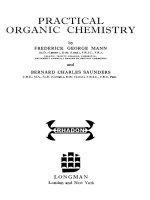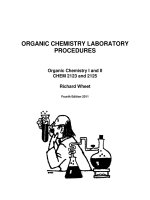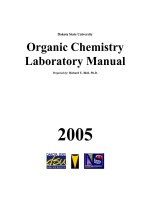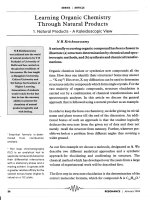Organic Chemistry Demystified Daniel Bloch, 2006
Bạn đang xem bản rút gọn của tài liệu. Xem và tải ngay bản đầy đủ của tài liệu tại đây (8.27 MB, 575 trang )
Organic Chemistry
Demystified
Demystified Series
Accounting Demystified
Advanced Statistics Demystified
Algebra Demystified
Anatomy Demystified
asp.net 2.0 Demystified
Astronomy Demystified
Biology Demystified
Biotechnology Demystified
Business Calculus Demystified
Business Math Demystified
Business Statistics Demystified
C++ Demystified
Calculus Demystified
Chemistry Demystified
College Algebra Demystified
Corporate Finance Demystified
Databases Demystified
Data Structures Demystified
Differential Equations Demystified
Digital Electronics Demystified
Earth Science Demystified
Electricity Demystified
Electronics Demystified
Environmental Science Demystified
Everyday Math Demystified
Forensics Demystified
Genetics Demystified
Geometry Demystified
Home Networking Demystified
Investing Demystified
Java Demystified
JavaScript Demystified
Linear Algebra Demystified
Macroeconomics Demystified
Management Accounting Demystified
Math Proofs Demystified
Math Word Problems Demystified
Medical Terminology Demystified
Meteorology Demystified
Microbiology Demystified
Microeconomics Demystified
Nanotechnology Demystified
OOP Demystified
Options Demystified
Organic Chemistry Demystified
Personal Computing Demystified
Pharmacology Demystified
Physics Demystified
Physiology Demystified
Pre-Algebra Demystified
Precalculus Demystified
Probability Demystified
Project Management Demystified
Psychology Demystified
Quality Management Demystified
Quantum Mechanics Demystified
Relativity Demystified
Robotics Demystified
Six Sigma Demystified
sql Demystified
Statistics Demystified
Technical Math Demystified
Trigonometry Demystified
uml Demystified
Visual Basic 2005 Demystified
Visual C# 2005 Demystified
xml Demystified
Organic Chemistry
Demystified
DANIEL R. BLOCH
McGRAW-HILL
New York
Chicago San Francisco Lisbon London
Madrid Mexico City Milan New Delhi
San Juan Seoul Singapore Sydney Toronto
Copyright © 2006 by The McGraw-Hill Companies, Inc. Inc. All rights reserved. Manufactured in the United States of America.
Except as permitted under the United States Copyright Act of 1976, no part of this publication may be reproduced or distributed in
any form or by any means, or stored in a database or retrieval system, without the prior written permission of the publisher.
0-07-148710-7
The material in this eBook also appears in the print version of this title: 0-07-145920-0.
All trademarks are trademarks of their respective owners. Rather than put a trademark symbol after every occurrence of a trademarked name, we use names in an editorial fashion only, and to the benefit of the trademark owner, with no intention of infringement of the trademark. Where such designations appear in this book, they have been printed with initial caps.
McGraw-Hill eBooks are available at special quantity discounts to use as premiums and sales promotions, or for use in corporate
training programs. For more information, please contact George Hoare, Special Sales, at or (212)
904-4069.
TERMS OF USE
This is a copyrighted work and The McGraw-Hill Companies, Inc. (“McGraw-Hill”) and its licensors reserve all rights in and to the
work. Use of this work is subject to these terms. Except as permitted under the Copyright Act of 1976 and the right to store and
retrieve one copy of the work, you may not decompile, disassemble, reverse engineer, reproduce, modify, create derivative works
based upon, transmit, distribute, disseminate, sell, publish or sublicense the work or any part of it without McGraw-Hill’s prior consent. You may use the work for your own noncommercial and personal use; any other use of the work is strictly prohibited. Your
right to use the work may be terminated if you fail to comply with these terms.
THE WORK IS PROVIDED “AS IS.” McGRAW-HILL AND ITS LICENSORS MAKE NO GUARANTEES OR WARRANTIES
AS TO THE ACCURACY, ADEQUACY OR COMPLETENESS OF OR RESULTS TO BE OBTAINED FROM USING THE
WORK, INCLUDING ANY INFORMATION THAT CAN BE ACCESSED THROUGH THE WORK VIA HYPERLINK OR
OTHERWISE, AND EXPRESSLY DISCLAIM ANY WARRANTY, EXPRESS OR IMPLIED, INCLUDING BUT NOT LIMITED TO IMPLIED WARRANTIES OF MERCHANTABILITY OR FITNESS FOR A PARTICULAR PURPOSE. McGraw-Hill and
its licensors do not warrant or guarantee that the functions contained in the work will meet your requirements or that its operation
will be uninterrupted or error free. Neither McGraw-Hill nor its licensors shall be liable to you or anyone else for any inaccuracy,
error or omission, regardless of cause, in the work or for any damages resulting therefrom. McGraw-Hill has no responsibility for
the content of any information accessed through the work. Under no circumstances shall McGraw-Hill and/or its licensors be liable
for any indirect, incidental, special, punitive, consequential or similar damages that result from the use of or inability to use the
work, even if any of them has been advised of the possibility of such damages. This limitation of liability shall apply to any claim
or cause whatsoever whether such claim or cause arises in contract, tort or otherwise.
DOI: 10.1036/0071459200
To Nan for her assistance, patience, and helpful comments.
This page intentionally left blank
For more information about this title, click here
CONTENTS
Preface
xvii
Acknowledgments
xix
CHAPTER 1
Structure and Bonding
Atomic Structure
Atomic Number and Atomic Mass (Weight)
Electron Energy Levels
The Octet Rule
Valences
Lewis Structures
Orbital Shapes
Quantum Mechanics
Bond Formation
Valence Bond Theory
Molecular Orbitals
Bonding and Antibonding MOs
Bonding and 3-D Molecular Shape
Curved Arrows
Electronegativity and Bond Polarity
Dipole Moments
Formal Charges
Resonance Structures
Intermolecular Forces
Quiz
1
1
3
4
7
8
9
15
15
18
20
21
21
23
30
31
33
34
36
37
39
CHAPTER 2
Families and Functional Groups
43
vii
CONTENTS
viii
CHAPTER 3
Acids and Bases
Introduction
Arrhenius Definition
Brønsted-Lowry Definition
Conjugate Acids and Bases
Equilibrium Reactions
Weak Hydrocarbon Acids
Lewis Acids and Bases
Quiz
46
46
47
47
47
49
53
54
56
CHAPTER 4
Alkanes and Cycloalkanes
Introduction
Sources of Alkanes
Acyclic and Cyclic Alkanes
Nomenclature
Formulas
Structures
Constitutional Isomers
Cycloalkanes
Alkyl Groups
Nomenclature—Naming Compounds
by the IUPAC System
Physical Properties
Chemical Properties
Conformations of Alkanes
Conformations of Cylcoalkanes
Quiz
59
59
60
60
61
62
62
64
66
67
CHAPTER 5
Stereochemistry
Isomers
Chiral Compounds
Stereocenters
Chirality Centers
Enantiomers
Racemic Mixtures
70
74
75
76
84
94
99
99
100
101
102
105
109
CONTENTS
ix
The R/S System
When the Lowest Priority Group Is Not
in the Back
Molecules with Multiple Asymmetric
Centers
Enantiomers
Diastereomers
Meso Compounds
Fisher Projections
Rotating Fisher Projections/Structures
Cyclic Stereoisomers
Naming Cyclic Stereoisomers
Prochiral Carbons (Wanabees)
Quiz
110
115
116
116
117
119
120
122
125
126
126
CHAPTER 6
Structure and Properties of Alkenes
Introduction
Structure
Naming Alkenes
Common Names
Cis and Trans Isomers
The E/Z (Easy) System
Degrees of Unsaturation
Stability of Alkenes
Physical Properties of Alkenes
Chemical Properties
The Curved Arrow
Quiz
129
129
130
132
134
134
135
136
140
141
141
142
142
CHAPTER 7
Reaction Mechanisms
Introduction
Thermodynamics
Kinetics
Carbocations
Stereochemistry
145
145
145
148
150
151
113
CONTENTS
x
CHAPTER 8
CHAPTER 9
The Hammond Postulate
Regiochemical Reactions
The Markovnikov Rule
Stereochemistry
Rearrangement Reactions of Carbocations
Quiz
152
154
155
156
157
159
Reactions of Alkenes
Reaction with Hydrogen Halides in Inert
Solvents
Reaction with Hydrogen Halides in Protic
Solvents
Oxymercuration-Demercuration Reactions
Hydroboration-Reduction
Halogenation in Inert Solvents
Stereochemistry Halogenation
Halogenation in Reactive Solvents
Radical Bromination
Formation of Diols
Double Bond Cleavage
Hydrogenation
Epoxides
Cyclopropanes
Quiz
161
Alkynes
Introduction
Structure
Nomenclature
Physical Properties
Chemical Properties
Reactions with Brønsted-Lowry Acids
185
185
185
186
188
188
189
161
162
165
167
171
173
174
175
177
178
180
180
181
182
CONTENTS
xi
Reactions with HBr and Peroxides
Reaction with Halogens
Hydration Reactions
Hydroboration-Oxidation Reactions
Hydrogenation/Reduction Reactions
Oxidation Reactions
Acidity of Alkynes
Alkylation Reactions
Preparation of Alkynes
Quiz
193
195
195
198
199
200
201
202
204
204
CHAPTER 10
Characterization
Introduction
Chromatography
Spectroscopy
UV Spectroscopy
Nuclear Magnetic Resonance Spectroscopy
Nuclear Properties
NMR Spectrometers
1 H NMR Spectroscopy
13 C NMR Spectroscopy
Mass Spectrometry
Quiz
207
207
207
212
222
226
226
228
230
243
246
251
CHAPTER 11
Organohalides
Introduction
Nomenclature
Properties
Preparation of Halides
Radical Halogenation
Isomeric Products
Allylic Halogenation
Reactions of Organohalides
Quiz
256
256
256
257
258
258
260
263
265
266
CONTENTS
xii
CHAPTER 12
CHAPTER 13
Nucleophilic Substitution and
Elimination Reactions
Introduction
Properties of Nucleophiles
Properties of Bases
Properties of Substrates/Electrophiles
Properties of Leaving Groups
Properties of Solvents
Second-Order Nucleophilic Substitution
(SN 2) Reactions
First-Order Nucleophilic Substitution
(SN 1) Reactions
Summary of SN 1 and SN 2 Reactions
Second-Order Elimination (E2)
Reactions
First-Order Elimination (E1) Reactions
Summary of E1 and E2 Reactions
Competition between Substitution and
Elimination Reactions
Quiz
Alcohols
Introduction
Properties of Alcohols
Nomenclature
Acidity and Basicity of Alcohols
Reactions with Active Metals
Preparation of Alcohols
Organometallic Compounds
Preparation of Alcohols Using
Organometallic Reagents
Reactions of Alcohols
Conversion of Alcohols to Alkyl Halides
Dehydration Reactions
Quiz
269
269
270
271
272
272
273
276
279
284
284
289
291
291
292
295
295
296
297
299
301
301
306
307
310
311
313
313
CONTENTS
xiii
CHAPTER 14
Ethers
Introduction
Nomenclature
Properties
Preparation of Ethers
Reactions of Ethers
Three-Membered Ether Rings
Quiz
317
317
317
318
319
321
323
327
CHAPTER 15
Sulfur Compounds
Nomenclature
Properties
Reactions of Sulfur Compounds
Quiz
330
330
331
333
335
CHAPTER 16
Conjugated Systems
Introduction
Stability of Dienes
Electrophilic Addition to Conjugated Dienes
Allylic Cations, Radicals, and Anions
Diels-Alder Reactions
Quiz
337
337
337
344
347
349
355
CHAPTER 17
Aromatic Compounds
358
Introduction
358
Reactivity of Aromatic Compounds
358
Nomenclature
359
Kekul´e Structures
361
Stability of Benzene
362
The Resonance Model
364
Molecular Orbital Description of Aromaticity 365
Properties of Aromatic, Nonaromatic, and
Antiaromatic Compounds
369
H¨uckel’s Rule
370
Heterocyclic Compounds
371
CONTENTS
xiv
Aromatic Ions
Polycyclic Aromatic Compounds
Quiz
372
374
375
CHAPTER 18
Reactions of Benzene and other
Aromatic Compounds
378
Introduction
378
Electrophilic Aromatic Substitution
379
Nucleophilic Aromatic Substitution
386
More Derivatives of Benzene
388
Multiple Substitution Reactions
392
Electrophilic Substitution in Disubstituted
Benzenes
399
Quiz
400
CHAPTER 19
Aldehydes and Ketones
Introduction
Nomenclature
Physical Properties
Chemical Properties
Preparation of Aldehydes and Ketones
Hydration of Alkynes
Reduction of Acid Chlorides
Reactions of Aldehydes and Ketones with
Nucleophiles
Wittig Reactions
Oxidation and Reduction Reactions
Quiz
404
404
405
408
408
410
412
414
Carboxylic Acids
Introduction
Nomenclature
Three-Dimensional Structure
Molecular Orbital (MO) Description
Physical Properties
430
430
431
434
434
435
CHAPTER 20
418
424
425
427
CONTENTS
xv
Acidity of Carboxylic Acids
Preparation of Carboxylic Acids
Derivatives of Carboxylic Acids
Quiz
437
439
444
444
CHAPTER 21
Derivatives of Carboxylic Acids
Introduction
Carboxylic Acid Halides
Carboxylic Acid Anhydrides
Carboxylic Esters
Amides
Cyclic Amides
Imides
Nitriles
Quiz
447
447
450
454
458
463
466
467
468
470
CHAPTER 22
Alpha-Substitution Reactions in
Carbonyl Compounds
Introduction
Enol and Enolate Anions
Alpha Monohalogenation of Aldehydes
and Ketones
α,β Unsaturated Ketones
α-Bromination of Carboxylic Acids
Acidity of α-Hydrogen Atoms
Malonic Ester Synthesis
Acetoacetic Ester Synthesis
Additional Condensation Reactions
Quiz
CHAPTER 23
Carbonyl Condensation Reactions
Introduction
Aldol Reactions
Dehydration of Aldol Compounds
Mixed or Crossed Aldol Reactions
474
474
475
477
479
479
479
483
485
486
488
490
490
491
492
493
CONTENTS
xvi
Intramolecular Aldol Reactions
Claisen Condensation Reactions
α-Substitution Reactions
Quiz
494
495
499
502
Final Exam
504
Quiz and Exam Solutions
531
Appendix A / Periodic Table
of the Elements
537
Bibliography
539
Index
541
PREFACE
Organic chemistry is the chemistry of carbon-containing compounds. Every
living organism, plant and animal, is composed of organic compounds. Anyone
with an interest in life and living things needs to have a basic understanding of
organic chemistry.
Articles continue to appear in newspapers and magazines describing the
development of new medicines and diagnostic tests. These new products and
technologies are results of a better understanding of the structure and function
of DNA, proteins, and other organic biological molecules. The reactions and
interactions of these complex molecules are the same reactions and interactions
that occur in more simple organic molecules.
This text was written to help those who are intimidated by the words organic
chemistry. Those who have never had a formal course in organic chemistry and
students currently taking or planning to take a formal course will find this text
an easy-to-read introduction and supplement to other texts.
The chapters are written in the same general order as found in most college
textbooks. It would be helpful, but not necessary, if the reader had a course in
introductory chemistry. The first three chapters cover the background material
typically covered in general chemistry courses. It is not necessary that chapters
be read sequentially, but since material tends to build on previous concepts it will
be easier to understand the material if the chapters are read in sequential order.
Key terms and concepts are italicized. Be sure you understand these concepts
as they will continue to appear in other sections of this book. Questions (and
answers) are given within each chapter to help you measure your understanding.
Each chapter ends with a quiz covering the material presented. Use each quiz
to check your comprehension and progress. The answers to quizzes are given
in the back of the text. Review those problems (immediately) you did not get
correct. Be sure you understand the concepts before going to the next chapter
as new material often builds upon previous concepts.
xvii
Copyright © 2006 by The McGraw-Hill Companies, Inc. Click here for terms of use.
xviii
PREFACE
As you read each chapter, take frequent breaks (you can munch on the extra
gum drops used to make models in Chapter 5). The book contains a lot of figures
and diagrams. Follow these as you read the text. It is often easier to understand
a reaction mechanism in a diagram than to describe it in words.
Yes, there is some memorization. New terms will appear that you probably
have never heard before. For a series of terms I recommend making a mnemonic
and I suggested a few. Reaction mechanisms are not as difficult as they may
appear. You can predict most reactions in that negative species will be attracted
to positive species (opposites attract). Atoms with electrons to share will be
attracted to species that want more electrons—it is just that simple.
There is a multiple-choice final exam at the end of the text. The final exam
has more general, but similar, questions than those in the quizzes. Answers are
given in the back of the book. If you are able to answer 80% of the final exam
questions correctly (the first time), you will have a good understanding of the
material.
I hope you will enjoy reading about organic chemistry as much as I have
enjoyed writing about it.
Daniel R. Bloch
ACKNOWLEDGMENTS
The author expresses his appreciation to Nan for her assistance, patience, and
helpful comments during the preparation of this book.
The following individuals were kind enough to review various chapters in
this book:
Vaughn Ausman, Marquette University
Kate Bichler, University of Wisconsin Center—Manitowoc
Peter Conigliaro (retired), S.C. Johnson
Sheldon Cramer (emeritus), Marquette University
Timothy Eckert, Carthage College
Sharbil Firson, Sigma-Aldrich
Kevin Glaeske, Wisconsin Lutheran College
Bruce Holman
Shashi Jasti, Sigma-Aldrich
Steven Levsen, Mount Mary College
Julie Lukesh, University of Wisconsin—Green Bay
Kevin Morris, Carthage College
Patt Nylen, University of Wisconsin—Milwaukee
Stephen Templin, Cardinal Stritch University
A special thanks to Priyanka Negi and Judy Bass who assisted with the
technical editing of this book.
xix
Copyright © 2006 by The McGraw-Hill Companies, Inc. Click here for terms of use.
This page intentionally left blank
Organic Chemistry
Demystified
xxi
Copyright © 2006 by The McGraw-Hill Companies, Inc. Click here for terms of use.
This page intentionally left blank
1
CHAPTER
Structure and
Bonding
Introduction
The study of organic chemistry involves the reactions and interactions of
molecules. Since molecules are composed of atoms, it is necessary to review
the structure of atoms and how they contribute to the properties of molecules.
Atomic Structure
Atoms are composed of a nucleus surrounded by electrons, as shown in Fig. 1-1.
The nucleus consists of positively charged protons and neutral neutrons. Although the nucleus consists of other subatomic particles, the proton, neutron,
and electron are the only subatomic particles that will be discussed in this text.
1
Copyright © 2006 by The McGraw-Hill Companies, Inc. Click here for terms of use.
CHAPTER 1
2
Structure and Bonding
Nucleus contains
protons and neutrons and is
about 0.0001 angstrom in diameter
Electron cloud
1Å
diameter
Fig. 1-1. Structure of an atom.
The atom is extremely small. It has a diameter of about 10−10 m
(0.000,000,000,1 m or 0.000,000,004 in.). These small dimensions are usu˚ where 1 A
˚ equals 1 ×10−10 m, or pm where
ally expressed in angstroms (A),
−12
1 pm equals 1 × 10
m. The nucleus is about 1/10,000th the diameter of the
−4 ˚
atom, or about 10 A. A key point: most of the volume of an atom is occupied
by the electrons. To put this in terms that are easier to understand, if the atom
was magnified so that the nucleus was the size of a marble, the area occupied by
the electrons would be the size of a football stadium. Take a minute to visualize
that. The area occupied by electrons is huge relative to that of the nucleus. The
area occupied by electrons is referred to as the electron cloud.
MASSES OF ATOMS
The mass of an atom is concentrated in the nucleus. A proton and a neutron
each have a mass of about 1.66 × 10−24 g. An electron has a mass of 1/1800th
that of a proton. Since these are such very small numbers, it is more convenient
to give the mass of a proton and a neutron in atomic mass units (amu). One
amu is equal to 1.66 × 10−24 g. The mass of individual atoms is also given in
a.m.u. The mass of 1 mole of atoms (a mole is a specific number, approximately
6.022 × 1023 ) is the atomic mass, which we usually call the atomic weight, of
an element. The atomic weight is expressed in grams/mol.
ELECTRON CLOUDS
Structures of molecules are usually written as shown in Fig. 1-2. Structure 1-2a
implies that atoms are quite far apart, relative to their size. This is certainly true
for the nuclei, but not for the electron clouds. The distance between a hydrogen
˚ The
nucleus and a carbon nucleus in a carbon-hydrogen bond is about 1.14 A.









